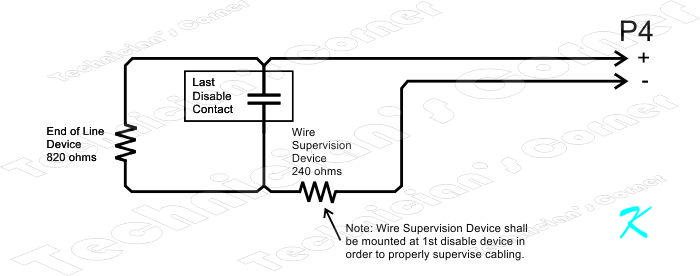Single Device
Sometimes, we have to look beyond what a device is labeled and look at what a device is and what it really does.
We still have the four conditions of the circuit as shown on the screw terminals of P4 on the control box.
- Normal - 8 volts(?) on the screw terminals
- Disabled - 3.9 volts (Zener voltage) on the screw terminals
- Open or Broken Wire - Power Supply voltage on the screw terminals
- Shorted Wires - 0 volts on the screw terminals
However, because of the exact location of the Wire Supervision Device (this is still a resistor), we have to mentally divide up the circuit between the wiring (shielded pair of wires) and the disable switch assembly (two resistors plus the Disable Contacts). All three components shown for the disable switch assembly have to be in the same box because any short condition to the left of the Wire Supervision Device (resistor) will be seen by the control box as a disable command rather than a short. (I'll explain further on down.)
Under normal circumstances, the contacts are open so no current flows through the switch. That leaves the End of Line Device (resistor) and the Wire Supervision Device (resistor) in series to pull the voltage down at the screw terminals of P4 of the control box. The total resistance of the End of Line Device (resistor of 820 ohms) and the Wire Supervision Device (resistor of 240 ohms) is 1060 ohms. That allows current to flow in the circuit (pulling the voltage at P4 down to around maybe 10 volts), showing the control box that the wires in the shielded pair of wires are complete and still connected at both ends.
Of course, a short in the twisted pair is still going to show up as a short to the control box because the voltage at P4 will still be pulled down to zero.
Now we get to the Wire Supervision Device. It does the exact same thing as the 3.9 volt Zener diode.
In the Single Disable Device circuit, the Disable Contact is wired across the End of Line Device (resistor). The 1st Disable Contact shorts out the End of Line Device (resistor) and allows a greater amount of current to flow through the Wire Supervision Device. The greater current pulls down the voltage at P4 to about what the 3.9 volt Zener diode pulls the voltage down to, sending the disable command to the Control Box.
The Control Box can't tell the difference between voltage pull downs by a Zener diode and voltage pull downs by a resistor. In either case, the signal sent is "greater electrical current" pulling down the voltage at P4 to about 3.9 volts. For all practical purposes, the resistor of the Supervision Device and the 3.9 volt Zener diode are the same device. Because of the exact wiring of the circuit, though, substituting one with the other may cause other problems.
Of course, the wire supervision resistor has to be mounted at the disable device so that an accidental wire to wire short in the wire will be seen by the Control Box as a short and not as a disable command.
There is no difference between the electrical contacts closing in the 1st Disable Contact and a wire-to-wire short to the left of the Wire Supervision Device. That means that the Wire Supervision Device (resistor) has to be installed at the Disable Contact rather than somewhere else in the circuit.
Multiple Device Wire Breaks
No electrical or electronic circuit is a catch-all for every circumstance. That's why someone should look at the control box both before and after maintenance.
Presumably, the Control Box is glanced at before any maintenance is performed. If there is trouble on the disable circuit, the trouble should be looked at before depending on the circuit to disable anything. Once the disable circuit is normal (without troubles), the disable circuit can be depended on while servicing the system.
If, while the 1st disable contact is closed, a wire breaks or comes loose further down in the circuit, the broken wire will not be detected by the Control Box.
Once the 1st disable contact is opened again and the open wire is still open, the Control Box will then show trouble. Just as a normal procedure, hopefully, the control box is at least glanced at once the maintenance is complete. The trouble will be seen and then the open wire will be fixed.
A wire-to-wire short, however, is going to be detected even when a disable contact is closed because the wire-to-wire short will short out all Zener diodes and the end of line device in the circuit.
Douglas Krantz

